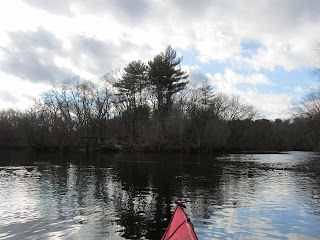Got out on the Assabet River in Concord, MA yesterday where my boat and I left our last wake of 2021. Visited one of my favorite touchstones, the Egg Rock inscription...
...where water levels have stayed in the text portion for most of 2021. Saw a couple of deer for a few fleeting moments, and towards the end of my paddle had an encounter with this male pileated woodpecker busily at work...
His vocalizations reminded me of one who whistles while he works.Paddling back to the takeout I reflected upon the past year. 2021 had plenty of ups and downs (both on and off the water). On my 2021 New Year's Day paddle I was gifted with this bald eagle sighting on the Sudbury River...
...an encounter that was a harbinger of many more 2021 eagle sightings including the privilege of watching a nest-bound pair of eaglets grow and ultimately fledge alongside the Assabet River. It was something I'd never expected to experience so close to home.
On the COVID front, the virus seemed to be relenting in the spring and some out-of-state travel restrictions were relaxed allowing a trip originally planned for 2020 to finally occur. It was a paddling/camping trip to western Maine in May where I was able to paddle and/or visit additional parts of the 1775 Arnold Expedition's route. I picked up their trail a few miles from where they left the Kennebec River and began a combined portaging/paddling to the Dead River and the Chain of Ponds. A three mile paddle upriver on the Kennebec (now Lake Wyman) brought me to a landing...
...where Arnold's expeditionary force began contending with some of the most difficult conditions they'd encounter on their journey from Cambridge, MA to Quebec City in Canada.A short hike from the landing brought me to this sign confirming I'd found the right place...
...and a spot I'd been envisioning for more than a year. Oftentimes I'd wondered if I'd ever be able to get there.Back in 1775, advance scouts established the course the 1100-man expeditionary force would follow at portages such as this one. In doing so the scouts used the surveyor's tools of the day: a quadrant compass for finding bearings, and a surveyor's chain for measuring distances. Once determined, the course and distance were posted at each of the many portaging places. It was about as simple as could be, a compass bearing and the distance that should be paced off. Looking at the steep portage trail...
In August I was grateful that the pandemic had subsided enough to allow the Blackburn Challenge with its paddling/rowing around Cape Ann to resume after having been cancelled in 2020. Though a scaled- back event it did nonetheless include the traditional course.
In September, thanks to a spot on WCVB's Chronicle television show, I was able to share my concerns regarding the amount of plastic in our waterways. Thank you to the Chronicle team: Sangita, George, and Brian.
Also in September I witnessed a fellow kayaker being rescued from a swift-flowing Nashua River in Harvard, MA. It was a sobering experience and one that left me acutely aware of just how fast things can go from good to bad for anyone out on the water.
Enjoyed some 2021 camping and paddling at Cathedral Pines Campground in Eustis ME, Wilgus State Park in Weathersfield, VT, and Cape Ann Campsite in Gloucester, MA.
One hopeful sign as 2021 comes to an end was a Xmas Day Boston Globe article by Nick Stoico mentioning the US Dept. of the Interior having restored the Mashpee Wampanoag Tribe's legal status and right to have land placed into reservation.
Trash encountered over the year included an ever-growing portion of so-called "nip" bottles such as these...
...each miniature bottle containing only 50 mls of alcohol.One of 2021's "nippiest" trash hauls was this one which included 222 of the little bite-sized bottles...
While I no longer count the pieces of trash recovered while paddling, I did however make it a point in 2021 to count "nip" bottles. There were 1,765 of them and of those 1,203 were recovered from one eight mile stretch of the Nashua River between Route 117 in Lancaster, MA and Ayer's Ice House Dam. Here's hoping 2022 might include an updated "Bottle Bill" which would place a redemption value on "nip" bottles as well as include other beverage containers not presently redeemable. The Massachusetts legislature could make it happen.
Yesterday's final trash haul of 2021...
Looking at the confluence of the Sudbury and Assabet rivers under yesterday's very changeable sky...










2 comments:
Al,
What a nice wrap up of a very productive year. Hope 2022's just as good for you.
Ron
Thanks Ron. Great to hear from you and may 2022 be a good one for you as well. Al
Post a Comment